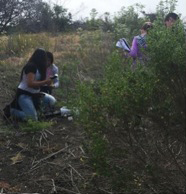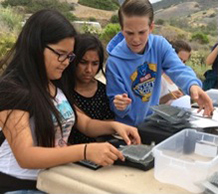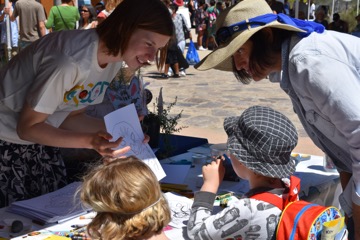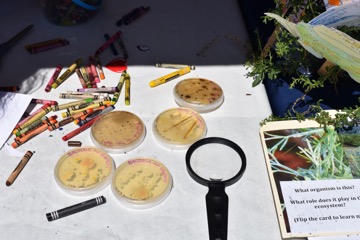As part of our NSF-funded projects, our lab facilitates science activities at Crystal Cove State Park and other local venues. Our goals are to:
- Promote education about the role of microorganisms in natural ecosystems
- Provide hands-on experiences that demonstrate the scientific method
- Increase awareness of the science underlying human-driven global changes
Below are examples of recents activities, relating to our projects about plant litter decomposition and marine viruses.
Role of Microbes in Climate Change
Microbial Decomposition and Habitat Restoration



In collaboration with science-education interns from the Center for Environmental Biology at UC Irvine and the Crystal Cove Alliance (a local nonprofit), we developed a project focusing on the role that microbes play in leaf litter decomposition (see the lesson plan and background reading about microbial decomposition). The module is run as part of the Coastal Field Science Program at the Berns Environmental Study Loop at the Crystal Cove State Park and is aimed at 5th-7th graders. The program highlights the incredible diversity of plants and microorganisms in the student’s own backyards and focuses on the many unknowns facing land managers trying to restore degraded habitats. Students are introduced to a leaf litter decomposition experiment. The experiment involves the deployment of leaf litterbags at two sites, a degraded site and a restored site. In each site, half of the litter bags contain native plants and half contain invasive plants. During the program, the students first learn about microbes, and the role that microbes play in plant litter decomposition and in the nitrogen and carbon cycles. The students then survey the sites, recording observations on plant type, ground cover and soil moisture. They form hypotheses as to which sites and litter types will promote conditions for faster decomposition. Finally, they weigh the leaf litter bags from each site and record mass. Using data provided with the initial mass of each bag, they are able to calculate mass loss and compare across the different treatments (degraded vs. restored land, invasive vs. native leaf litter). The data recorded by each class of students is being compiled over time. Through this hands-on experience, students are being introduced to the hidden biodiversity present in our local ecosystems.
Hidden Biodiversity
Our lab participates in Earth Day events at UCI and Newport Bay Conservancy. At these events, several UCI research groups involved in the Orange County Society for Conservation Biology showcase activities highlighting the hidden biodiversity in our local ecosystems. In recent years, our PhD students have contributed a focus on microbes, making visible a few of the many bacteria and fungi that we work and describing the key roles they play in native California ecosystems.


